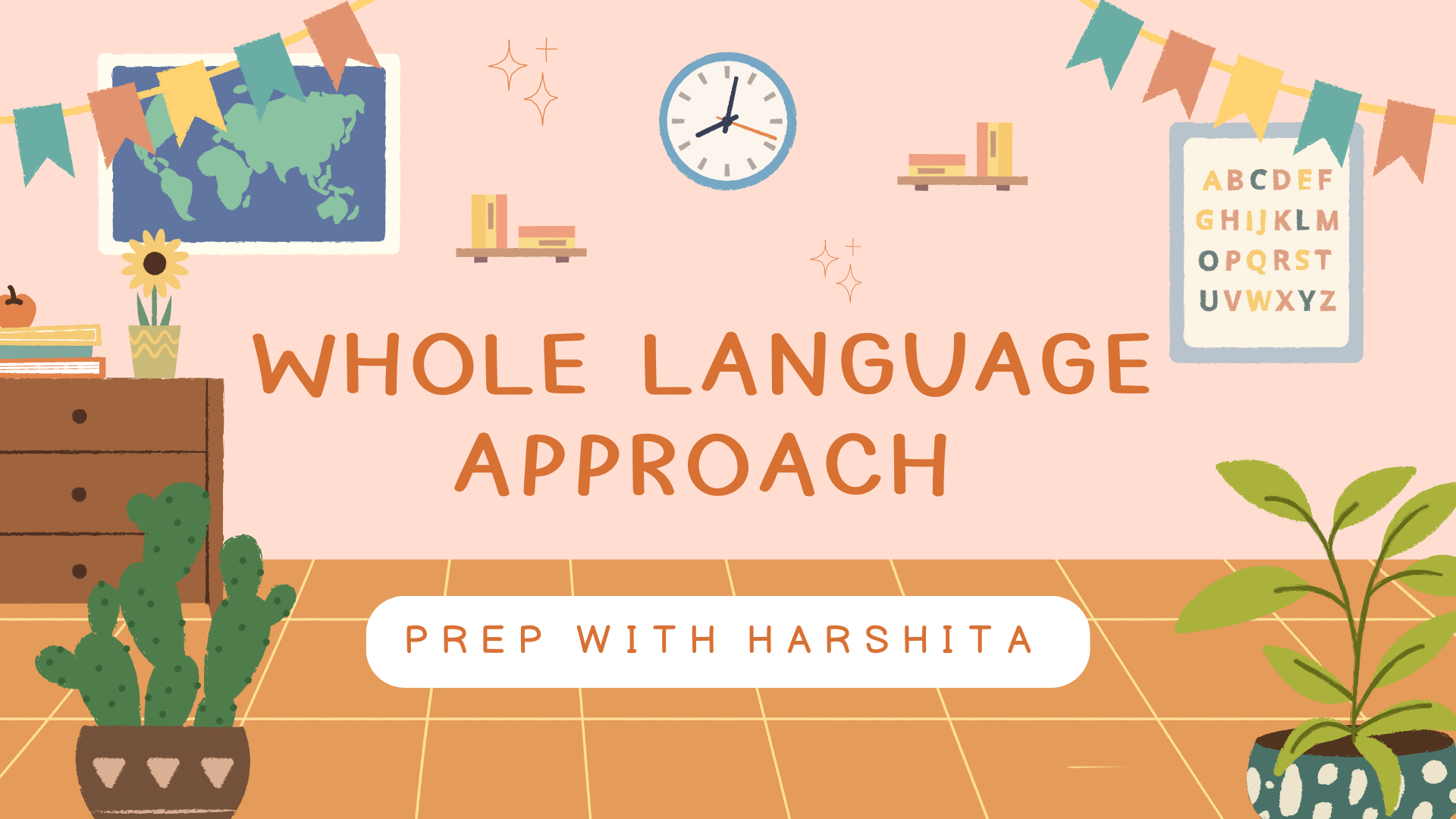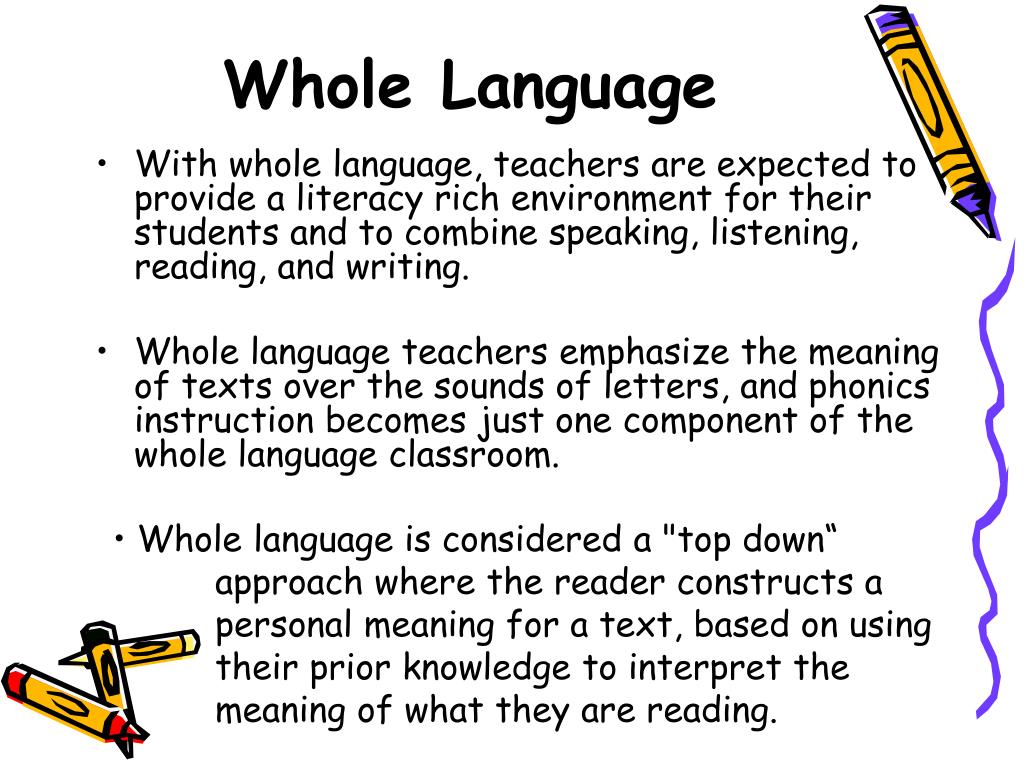As the whole language approach takes center stage in the educational landscape, it invites educators and learners alike to embark on a transformative journey that redefines language instruction. This innovative approach prioritizes authentic experiences, meaningful communication, and student empowerment, fostering a holistic and engaging learning environment.
The whole language approach is rooted in the belief that language is best learned through its natural and comprehensive use. It departs from traditional methods by emphasizing real-world contexts, encouraging students to interact with language as a living, dynamic force.
Overview of the Whole Language Approach

The whole language approach is a method of language teaching that emphasizes the use of authentic texts and meaningful activities to develop students’ language skills. It is based on the idea that language is a natural process that is best learned through exposure to real-world language use.The
whole language approach was developed in the 1980s by educators such as Ken Goodman, Yetta Goodman, and Marie Clay. It was a reaction to the traditional grammar-translation method of language teaching, which focused on teaching students the rules of grammar and vocabulary in isolation.
The whole language approach, on the other hand, emphasizes the importance of context and meaning in language learning.The whole language approach has a number of key principles, including:* Language is a natural process that is best learned through exposure to real-world language use.
- Students learn best when they are actively engaged in meaningful activities that use language.
- The whole language approach emphasizes the importance of context and meaning in language learning.
- Students should be encouraged to use their own language and experiences to make sense of new language.
The whole language approach is a holistic approach to language teaching that focuses on developing all four language skills
listening, speaking, reading, and writing.
The whole language approach differs from traditional language teaching methods in a number of ways. First, the whole language approach emphasizes the use of authentic texts, such as stories, poems, and articles. Traditional language teaching methods, on the other hand, often use simplified texts that are designed to teach specific grammar points or vocabulary items.
Second, the whole language approach emphasizes the importance of meaningful activities. Traditional language teaching methods, on the other hand, often focus on rote memorization and drills. Third, the whole language approach emphasizes the importance of context and meaning. Traditional language teaching methods, on the other hand, often focus on teaching grammar and vocabulary in isolation.The
whole language approach has been shown to be an effective method of language teaching. Studies have shown that students who are taught using the whole language approach make more progress in their language skills than students who are taught using traditional methods.
The whole language approach is also a more enjoyable way to learn a language, as it allows students to use their own language and experiences to make sense of new language.
History of the Whole Language Approach
The whole language approach was developed in the 1980s by educators such as Ken Goodman, Yetta Goodman, and Marie Clay. It was a reaction to the traditional grammar-translation method of language teaching, which focused on teaching students the rules of grammar and vocabulary in isolation.
The whole language approach, on the other hand, emphasizes the importance of context and meaning in language learning.The whole language approach was influenced by a number of different factors, including:* The work of linguists such as Noam Chomsky and Halliday, who argued that language is a natural process that is best learned through exposure to real-world language use.
- The work of psychologists such as Lev Vygotsky, who argued that children learn best through social interaction and collaboration.
- The work of educators such as John Dewey, who argued that learning should be child-centered and based on the child’s own experiences.
The whole language approach has been widely adopted in many countries around the world. It is a popular approach to language teaching in elementary schools, as it is well-suited to the needs of young learners. The whole language approach is also used in some secondary schools and adult education programs.
Key Components of the Whole Language Approach
The Whole Language Approach is a comprehensive approach to language teaching that emphasizes the use of authentic materials, meaningful communication, student choice, and literature to develop students’ language skills.
The key components of the Whole Language Approach include:
Authentic Materials
Authentic materials are real-world texts that have not been created specifically for language learners. They can include newspapers, magazines, books, websites, and videos. Using authentic materials exposes students to the language as it is actually used and helps them to develop a more natural and authentic understanding of the language.
Focus on Meaningful Communication
The Whole Language Approach emphasizes the importance of meaningful communication. This means that students are encouraged to use language to communicate real ideas and information, rather than simply memorizing grammar rules and vocabulary. Meaningful communication can take place in a variety of contexts, such as conversations, discussions, and writing.
Encouragement of Student Choice
The Whole Language Approach encourages students to make choices about their own learning. This can include choosing the topics they want to study, the materials they want to use, and the activities they want to participate in. Student choice helps to motivate students and makes learning more enjoyable.
Use of Literature
Literature is a valuable resource for language teaching. It can expose students to different genres of writing, introduce them to new vocabulary and grammar structures, and help them to develop their critical thinking skills. Literature can also be used to spark discussions about important social and cultural issues.
Benefits of the Whole Language Approach

The whole language approach offers numerous benefits to students, fostering their literacy skills and overall academic success. Research has consistently demonstrated the positive impact of this approach on various aspects of language development.
One of the most significant benefits of the whole language approach is improved reading comprehension. By engaging students in meaningful and authentic texts, this approach helps them develop a deep understanding of the content they read. Students learn to make connections between different parts of the text, identify main ideas, and draw inferences, leading to a more comprehensive and critical reading experience.
Enhanced Writing Skills
The whole language approach also enhances students’ writing skills. By providing opportunities for students to write in a variety of genres and for different purposes, this approach encourages them to develop their own writing styles and express themselves effectively. Students learn to organize their thoughts, use appropriate vocabulary and grammar, and produce cohesive and engaging written pieces.
Increased Motivation and Engagement
Another key benefit of the whole language approach is increased student motivation and engagement. By incorporating authentic and meaningful materials, this approach makes learning relevant and enjoyable for students. Students are more likely to be engaged in activities that they find interesting and meaningful, leading to a more positive and productive learning environment.
Challenges of the Whole Language Approach
The implementation of the whole language approach can pose several challenges:
Teacher Training and Professional Development, Whole language approach
Educators must be adequately trained in the principles and practices of the whole language approach. This includes understanding the theoretical underpinnings, effective instructional strategies, and assessment techniques. Without proper training, teachers may struggle to implement the approach effectively.
Availability of Resources
The whole language approach requires a wide range of authentic texts, including books, magazines, newspapers, and other print materials. Schools may need to invest in acquiring these resources or develop partnerships with local libraries and community organizations.
Assessment of Student Progress
Traditional assessment methods may not be appropriate for evaluating student progress in a whole language classroom. Educators need to develop alternative assessment strategies that focus on students’ overall language development and ability to apply their knowledge in meaningful contexts.
Variations of the Whole Language Approach
The whole language approach encompasses several variations, each emphasizing different aspects of language learning.
Natural Language Acquisition
This variation emphasizes the natural process of language acquisition, similar to how children learn their first language. It focuses on exposing learners to authentic language through reading, listening, and speaking activities.
Content-Based Language Learning
This variation integrates language learning with the study of other subject areas, such as science, history, or math. Learners acquire language while exploring content that is meaningful and engaging to them.
Task-Based Language Learning
This variation centers around completing real-world tasks that require learners to use language in meaningful ways. It emphasizes communication and problem-solving skills, with tasks designed to reflect real-life situations.
Applications of the Whole Language Approach

The whole language approach can be applied in various educational settings to enhance literacy development and foster a love for reading and writing.
Early Childhood Education
In early childhood settings, the whole language approach encourages young learners to engage in meaningful literacy experiences through play, storytelling, and exploration of print-rich environments. By immersing children in a language-rich atmosphere, they develop a natural curiosity and enthusiasm for language and literacy.
Elementary and Secondary Education
In elementary and secondary schools, the whole language approach emphasizes the integration of reading, writing, speaking, and listening skills. Students are encouraged to engage in authentic literacy activities, such as reading aloud, writing journals, and participating in class discussions. This approach fosters critical thinking, problem-solving, and collaboration skills.
English Language Teaching
The whole language approach is particularly effective in English language teaching, especially for non-native speakers. By exposing students to authentic texts and providing opportunities for meaningful language use, this approach helps learners develop fluency and proficiency in the target language.
Epilogue
In conclusion, the whole language approach offers a compelling framework for language teaching and learning. By immersing students in authentic language experiences, fostering meaningful communication, and empowering them with choice, it cultivates a lifelong love for language and unlocks their potential as proficient communicators.
FAQ Overview
What are the key principles of the whole language approach?
The whole language approach is guided by principles such as authenticity, meaningful communication, student choice, and the use of literature.
How does the whole language approach differ from traditional language teaching methods?
Unlike traditional methods that focus on isolated language skills, the whole language approach emphasizes the interconnectedness of language and learning through immersive experiences.
What are the benefits of using the whole language approach?
Research indicates that the whole language approach enhances reading comprehension, writing skills, motivation, and overall engagement in language learning.